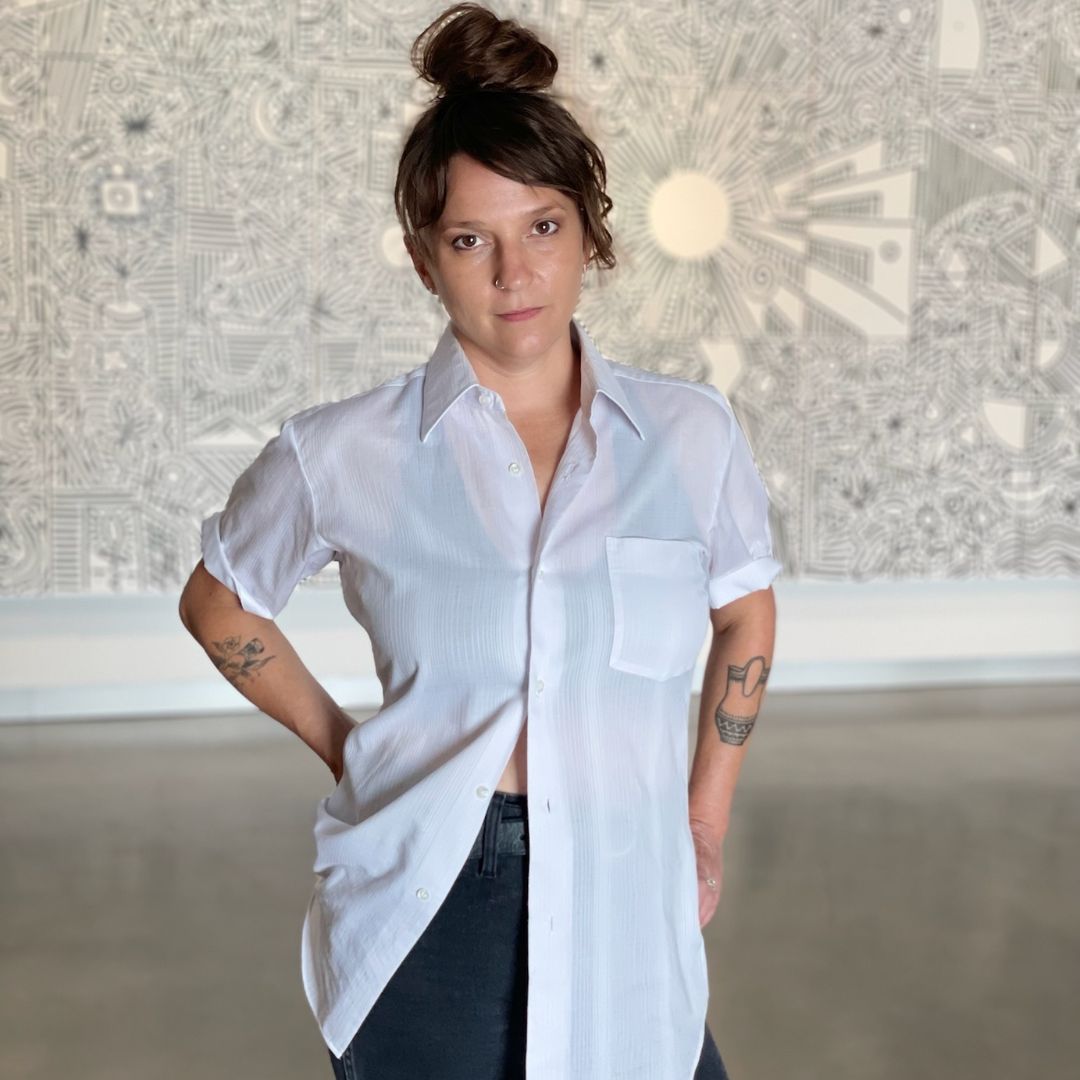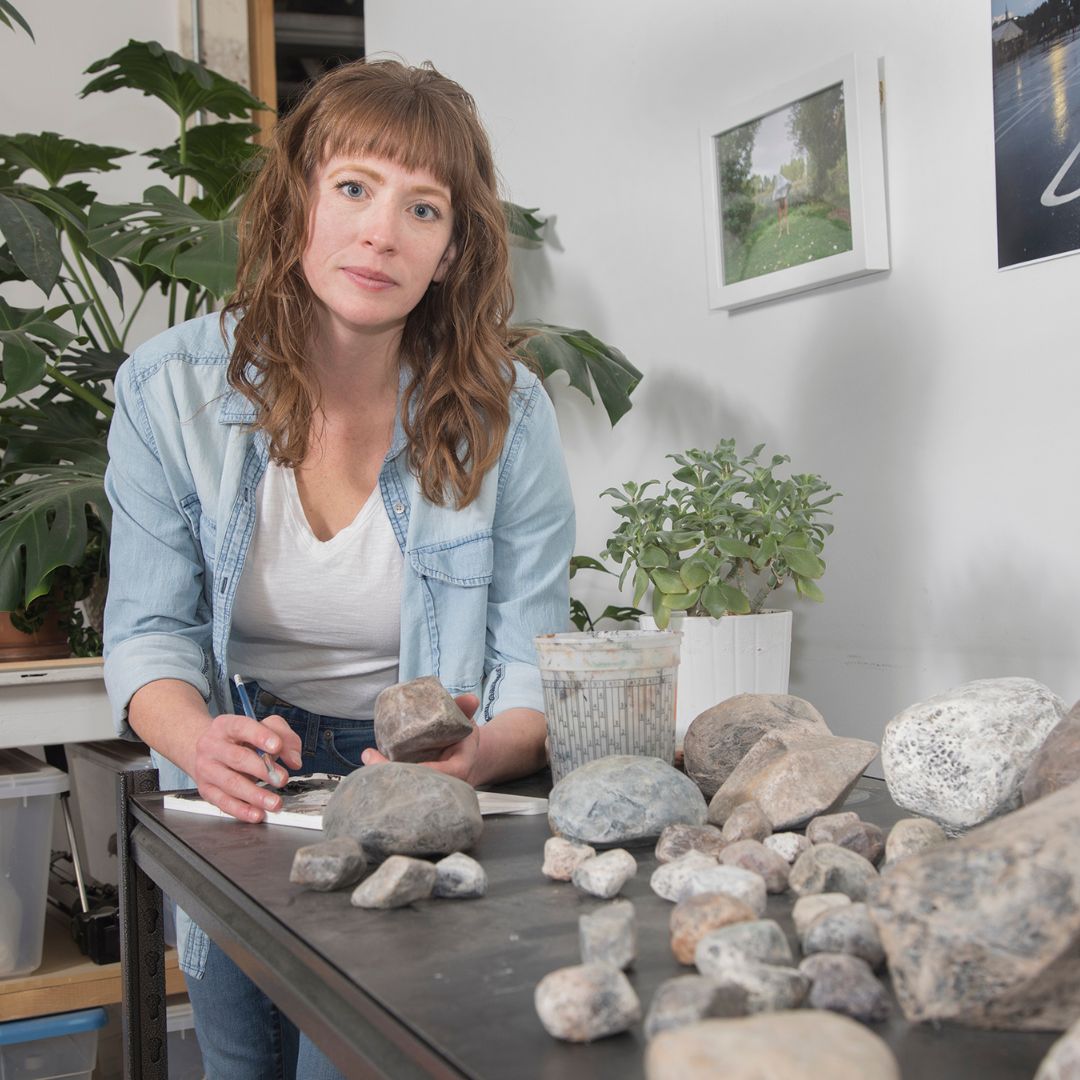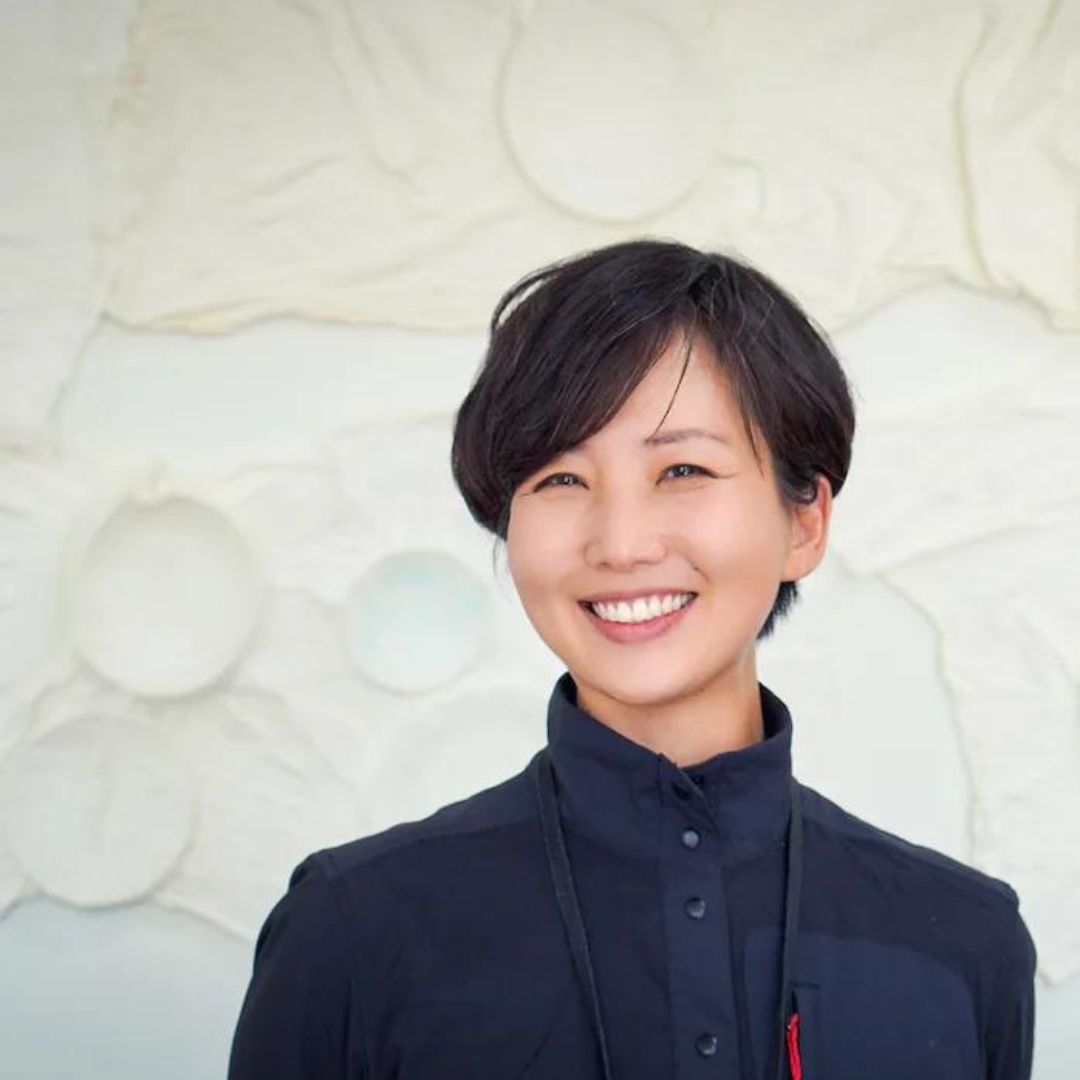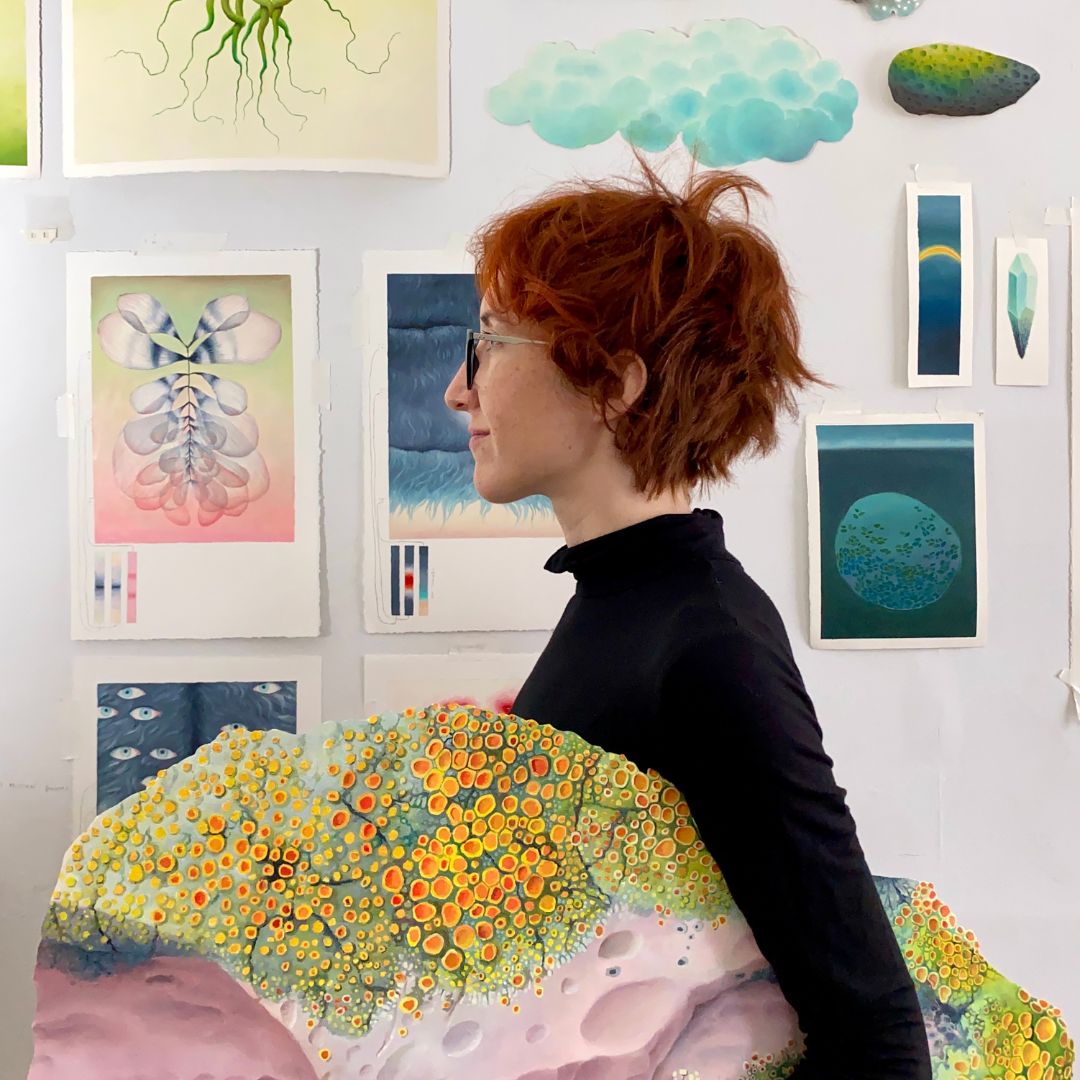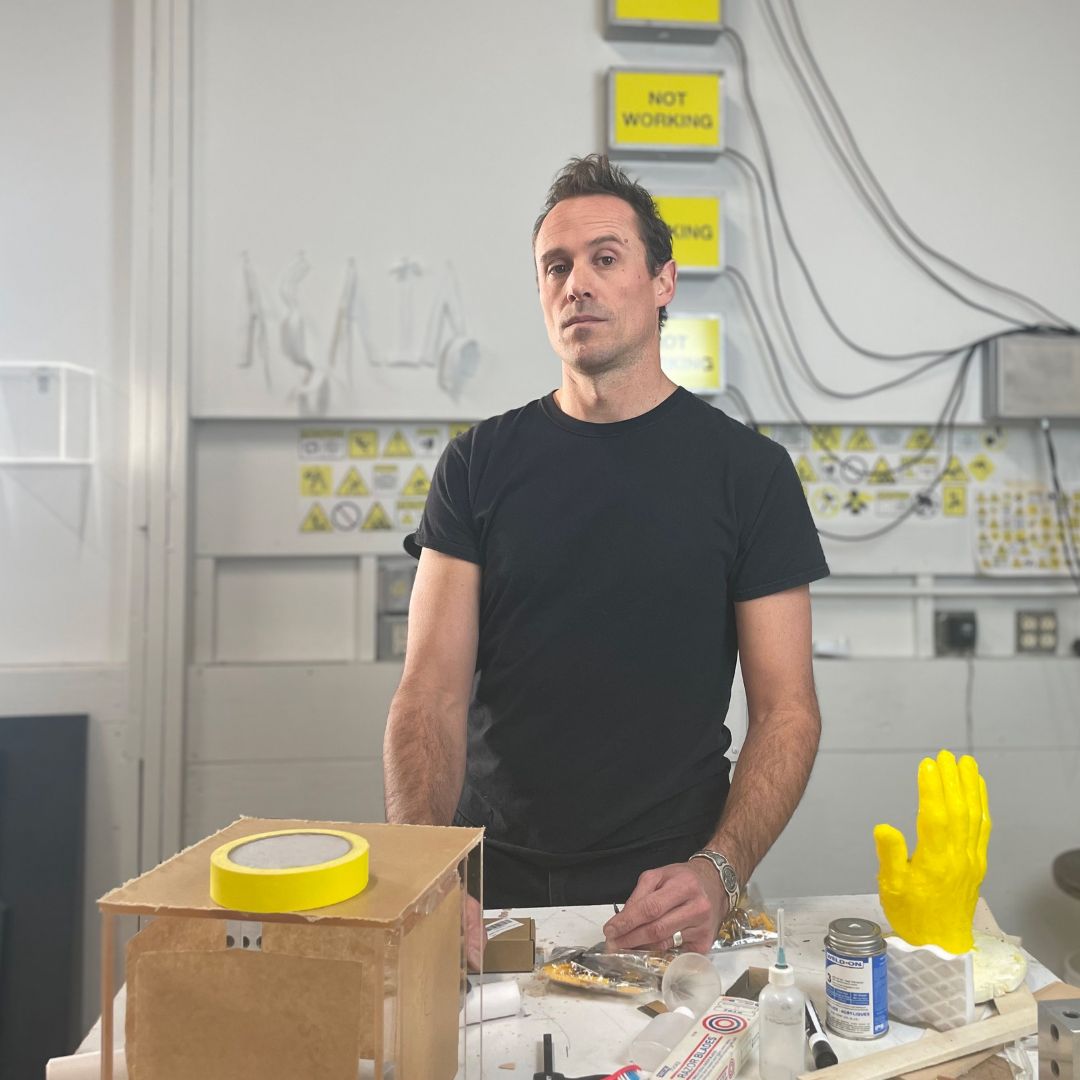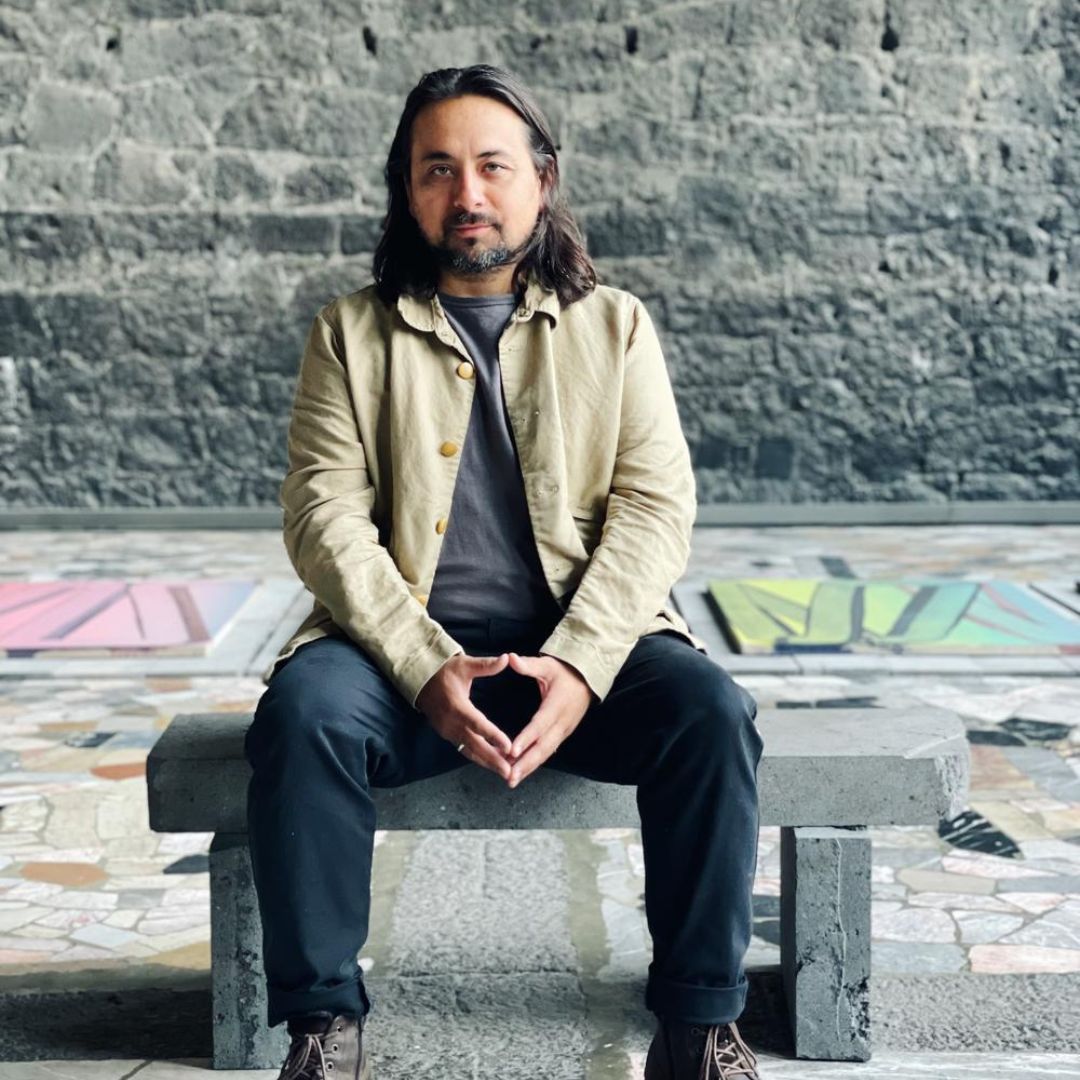Breakthroughs Mobile Tour Guide
Level 2
Located on Level 2
Located on Level 2
Installation view, Breakthroughs: A Celebration of RedLine at 15, Museum of Contemporary Art Denver, February 24, 2023– May 28, 2023. Photo by Wes Magyar
Located on Level 2
Welcome to Level 2 of the Breakthroughs exhibition Mobile Tour Guide! On this page you’ll find audio content from exhibiting artists Trey Duvall, Ana María Hernando, Sammy Seung-Min Lee, Jeff Page, and Gretchen Marie Schaefer. In their work these artists explore their relationships and the meanings we associate with everyday objects in the natural environment.
ENGLISH
TRANSCRIPTION
I'm Trey Duvall. Pronouns are he, him, his. I'm an artist working in Denver, Colorado. I grew up in Durango. It's kind of a smaller town in Southwest Colorado. Some of the themes in my work are absurdity, futility, exhaustion, entropy, and certainly humor, and how objects can be manipulated or used to make meaning or how they're inherent meaning that's associated with the object can be engaged or deployed in different ways. I'm always looking for things that are widely understood. That have a, at least in my mind, a humor or a way that they're not used or that they can be used that is kind of within that idea of a not correct use of a thing. And I think the ladders have a lot of that. And so this work, the 002, it's the second work in a series. I saw Someone Fall Off A Ladder. So that kind of started this piece. I could see the legs of it starting to warp a little bit. And then of course, the resulting fall off the ladder and the person, the stretching or the traction part of it is something that I've been thinking about with these kinetic works and with ways to make motion or to reveal motion. Things happening on a really long timeline so that the works that are happening in the gallery aren't an aftermath. They're not what's left behind of a process, but that process is kind of drawn out throughout an exhibition. So someone can come and go and the work is ongoing and unfolding.
SPANISH
TRANSCRIPCIÓN
Soy Trey Duvall. Mis pronombres son “él” y “suyo”. Soy un artista que trabaja en Denver, Colorado. Crecí en Durango, una especie de ciudad, pero pequeña, en el suroeste de Colorado. Algunos de los temas de mi trabajo son el absurdo, la inutilidad, el agotamiento, la entropía y, sin duda, el humor, y cómo los objetos pueden manipularse o usarse para generar significado o cómo su significado inherente asociado con el objeto puede comprometerse o desplegarse en diferentes maneras. Siempre estoy buscando cosas que sean ampliamente entendidas. Cosas que, al menos en mi mente, tienen un humor o una forma en que no se usan o que se pueden usar que está dentro de esa idea de un uso incorrecto de una cosa. Y creo que las escaleras tienen mucho de eso. Y entonces este trabajo, el 002, es el segundo trabajo de una serie llamada “Vi Alguien Caerse De Una Escalera.” Así que de esa manera comenzó esta pieza. Pude ver que las patas comenzaban a deformarse un poco. Y luego, por supuesto, la caída resultante de la escalera y la persona, la parte de estiramiento o tracción es algo en lo que he estado pensando con estos trabajos cinéticos y con formas de hacer movimiento o revelar movimiento. Las cosas suceden en una línea de tiempo realmente larga para que las obras que suceden en la galería no sean una secuela. No son lo que queda de un proceso, pero ese proceso se prolonga a lo largo de una exposición. Entonces alguien puede ir y venir y la obra sigue desarrollándose continuamente.
ENGLISH
TRANSCRIPTION
My name is Ana María Hernando, and I am originally from Argentina. I'm a visual artist. I have been a visual artist all my life. And Colorado is the place I have lived for the longest. I love materials, and I love exploring different materials. I come from a family of textiles. So my maternal grandparents began a small textile factory in Buenos Aires, where I was going as a teenager, and working there in the summers. So these pieces that are made with a lot of tulle, I have a whole process where I choose the colors I combine. Tool is very transparent. So in that way, it's very pictorial, and it allows me to bring together the part of me that is a painter, and the part of me that is a sculptor. So I combine and I use it, so I get to the color I want, with the vibrancy I want. And then with my assistants and I, we weave it through a frame. And then I shave it, and there is the piece. So when I name all my pieces, I do that. That's the very, very last thing I do. My mind goes from the Spanish to the English, from the English to the Spanish. So I like to show that in my titles, as a door for people, another way of getting to work. And I sit with the piece, and I think, "What's the title?" Many times, I use parts of my poems. Other times, I use parts of other people's poems, and I go from there.
SPANISH
TRANSCRIPCIÓN
Mi nombre es Ana María Hernando y soy originaria de Argentina. Soy una artista visual. He sido artista visual toda mi vida. Colorado es el lugar donde he vivido por más tiempo. Me encantan los materiales y me encanta explorar diferentes materiales. Vengo de una familia de textiles. Mis abuelos maternos abrieron una pequeña fábrica textil en Buenos Aires, donde yo iba de adolescente y trabajaba allí en los veranos. Entonces estas piezas que están hechas con muchas herramientas. Tengo todo un proceso donde elijo los colores, los combino. La herramienta es muy transparente. Entonces, de esa manera, es muy pictórico y me permite unir mi parte de pintora y mi parte de escultora. Así que lo combino y lo uso, así consigo el color que quiero, con la vitalidad que quiero. Y luego, con mis asistentes y yo, lo tejemos a través de un marco. Y luego lo afeito, y ahí está la pieza. Entonces, cuando nombro todas mis piezas, hago eso. Eso es lo último, lo último que hago. Mi mente va del español al inglés, del inglés al español. Entonces me gusta mostrar eso en mis títulos, como una puerta para la gente, otra forma de llegar al trabajo. Y me siento con la pieza y pienso: "¿Cuál es el título?" Muchas veces uso partes de mis poemas. Otras veces, uso partes de los poemas de otras personas y desde allí comienzo.
ENGLISH
TRANSCRIPTION
My name is Sammy Lee. I'm a Denver-based artist. I came from South Korea at age 16. I chose to come here without parents, so I'm a first generation immigrant. My arrived, it's all black suitcases, referencing anonymous identity at the arrival of... as unique as who you are coming from where you are, once you arrive, sometime you feel very anonymous or misunderstood. Suitcase, when I see it, because of my immigrant history, it's kind of loaded object with emotions. And it really has that meaning of departure and parting with your motherland and with your family. And whenever still I go to the airport and see immigrant arriving with that suitcase, I revisit that emotional side of it. So to me, suitcase is not thinking about what to wear in your vacation and nice sweater or whatever. It is really that consolidation of your life and really thinking about what you can live without. And that editing process and what's inside the suitcase is really unique. That's just really who you are. So that those are the stories that I tell through it.
SPANISH
TRANSCRIPCIÓN
Mi nombre es Sammy Lee. Soy un artista y vivo en Denver. Vine de Corea del Sur a los 16 años. Elegí venir aquí sin mis padres, así que soy un inmigrante de primera generación. Mi llegada… Son todas maletas negras, haciendo referencia a la identidad anónima a la llegada de... tan único como quién eres, de dónde eres. Una vez que llegas, a veces te sientes muy anónimo o incomprendido. Maleta, cuando la veo, por mi historia de inmigrante, es como un objeto cargado de emociones. Y realmente tiene ese significado de partida y despedida de tu patria y de tu familia. Y cada vez que voy al aeropuerto y veo llegar a un inmigrante con esa maleta, vuelvo a visitar ese lado emocional. Entonces, para mí, la maleta no es pensar en qué ponerte en tus vacaciones y un buen suéter o lo que sea. Es realmente esa consolidación de tu vida y realmente pensar en lo que puedes vivir sin él. Y ese proceso de edición y lo que hay dentro de la maleta es realmente único. Eso es realmente lo que eres. Así que esas son las historias que cuento a través de él.
ENGLISH
TRANSCRIPTION
Jeff Page, I'm a visual artist. I'm born and raised in Denver, so I'm like a multidisciplinary artist, truly multidisciplinary. I shift around mediums all the time, mostly doing video work these days. In making THROAT CHAQRA THERAPY, which is the first video in this series that I'm working on, it was the first one that I made. I really thought about it for a while. I just sat with, "What do I want to do with this idea?" And I was also, this is crazy to say, but it wasn't until I was in my thirties, I realized how much shame I still had around my voice and the way I talk. And I was just reflecting on how much I was bullied as a kid for the way I talked and sounding gay and stuff like that. And how much that was still a part of me, even as an adult. You think you're grown out of this stuff and I realized that I still had that within me. And so I was like, "All right, I'm going to make something that's really about that." Which was kind of cringey. I was like, "Oh, I'm going to really be putting myself out here in this really personal way," but I was like, "I'm just going to try it." And so in thinking through all these things, I also thought about how I had thyroid cancer. This is 10 years ago now. And through doing this research and putting this video together, I made this connection between my thyroid cancer and being bullied as a kid for the way I talked. And then I came into this idea and this idea that people who are silenced or conditioned to be silent have a sort of dead energy chakra here. And so that lit up all these ideas for me and making this video. So I was like, "I'm going to make an experimental therapy video on exercising that throat chakra." Using these really clichéd gay terms from drag race or just from gay mainstream culture. And using that as a tool for therapy for this therapy video that I was going to make.
SPANISH
TRANSCRIPCIÓN
Soy Jeff Page, un artista visual. Nací y crecí en Denver, así que soy como un artista multidisciplinario, verdaderamente multidisciplinario. Cambio de medio todo el tiempo, principalmente haciendo trabajos de video en estos días. Al hacer THROAT CHAQRA THERAPY (Terapia Chakra para la Garganta), que es el primer video de esta serie en el que estoy trabajando, fue el primero que hice. Realmente lo pensé por un tiempo. Simplemente me senté con, "¿Qué quiero hacer con esta idea?" Y yo también, es una locura decirlo, pero no fue hasta que cumplí los treinta, que me di cuenta de cuánta vergüenza tenía todavía por mi voz y mi forma de hablar. Y solo estaba reflexionando sobre cuánto me intimidaron cuando era niño por la forma en que hablaba y sonaba gay y cosas así. Y cuánto eso todavía era parte de mí, incluso como adulto. Crees que has crecido fuera de estas cosas y me di cuenta de que todavía tenía eso dentro de mí. Entonces dije: "Está bien, voy a hacer algo que realmente se trate de eso". Lo cual fue un poco vergonzoso. Pensé: "Oh, realmente voy a exponerme aquí de esta manera muy personal", pero dije: "Voy a intentarlo". Y así, al pensar en todas estas cosas, también pensé en cómo tenía cáncer de tiroides. Esto ocurrió hace 10 años. Y al hacer esta investigación y armar este video, hice esta conexión entre mi cáncer de tiroides y el hecho de que me intimidaran cuando era niño por mi forma de hablar. Y luego llegué a esta idea y esta idea de que las personas que están silenciadas o condicionadas para estar en silencio tienen una especie de chakra de energía muerta aquí. Y eso iluminó todas estas ideas para mí y hacer este video. Así que dije: "Voy a hacer un video de terapia experimental sobre cómo ejercitar ese chakra de la garganta". Usando estos términos gay realmente cliché de carreras de resistencia o simplemente de la cultura gay dominante. Y usar eso como herramienta de terapia para este video de terapia que iba a hacer.
ENGLISH
TRANSCRIPTION
I'm Gretchen Marie Schaefer. I am an artist, and I was born and raised, and currently live and work in Denver, Colorado. I love any medium that's tactile. I am a somatic thinker and maker, so my body often knows what to do before my brain maybe does. I have a lot of trust in my hands and my skills, and even in my imagination. So, I like mediums in which I can lead with that. More recently, I've just been interested in perception generally, and how perception is very slippery. Our mind can contort things and we can see what's not actually there. We can fall for a magic trick. There's illusion and there's things in our world that can cloud our vision. What objects then play in that space and help us remind ourselves that our vision is not always so certain? I've been thinking about perception and relationship to a very reliable object, which are rocks. We know what to expect from a rock. We see a rock. We know it's probably hard. We know it's probably heavy. It's a trusted thing. It feels solid, and it can be as small as rocks on a road that you can drive across, to mountains right here in Colorado, and so making paper mache sculptures that look just like rocks, but allow me to put them in context of illusion or ambiguity... I can lift them up because they're light. I can put them on my body, I can put them in situations they're not supposed to be in. We can check those assumptions in our perception, and maybe it opens up a space that oh, maybe things aren't the way just I experience the world. How can this build consideration for other people's experiences? So, the paper mache sculpture is made like what you learned when you were in grade school, how to make paper mache. The paper I use for the sculptures are the New York Times because they were an interesting place of debate of truthfulness. Some people look to the news and journalism as a place where you can get trusted sources. How are we processing what's happening to our world and our communities? Some people look at that paper as full of lies, and untruths, and misinformation. So, I think using the newspaper is a really important thing. No one will ever know that, but it is the material that makes up these rocks, so that's the base material. I create these sculptures by looking and observing other real rocks, and I make up a sort of shape that is rocklike and cover it in paper mache, paper mache clay, and then it's just acrylic paint. I layer the paint like a lot of painters where you start with the deeper, darker shadow spaces. Then I build up highlights onto the surface, and even the creation of the tech texture with paper mache clay lends itself to a rocklike surface. So, I can really lean on the material to create the illusion of rockness for these sculptures.
SPANISH
TRANSCRIPCIÓN
Soy Gretchen Marie Schaefer. Soy artista. Nací y me crié y actualmente vivo y trabajo en Denver, Colorado. Me encanta cualquier medio que sea táctil. Soy una pensadora y creadora somática, por lo que mi cuerpo a menudo sabe qué hacer antes de que mi cerebro lo sepa. Tengo mucha confianza en mis manos y mis habilidades e incluso en mi imaginación. Me gustan los medios en los que puedo liderar con eso. Más recientemente, me he interesado en la percepción en general y en cómo la percepción es muy resbaladiza. Nuestra mente puede distorsionar las cosas y podemos ver lo que en realidad no está ahí. Podemos caer en un truco de magia. Hay ilusión y hay cosas en nuestro mundo que pueden nublar nuestra visión. ¿Qué objetos juegan entonces en ese espacio y nos ayudan a recordar que nuestra visión no siempre es tan certera? He estado pensando en la percepción y la relación con un objeto muy fiable, que son las rocas. Sabemos qué esperar de una roca. Vemos una roca. Sabemos que probablemente sea dura. Sabemos que probablemente sea pesada. Es algo de confianza. Se siente sólido, y puede ser tan pequeño como rocas en un camino que puedes cruzar, o tan grande como las montañas aquí en Colorado. Así, hago esculturas de papel maché que parecen rocas, pero permíteme ponerlas en el contexto de la ilusión. o ambigüedad... Puedo levantarlos porque son ligeros. Puedo ponerlos en mi cuerpo, puedo ponerlos en situaciones en las que se supone que no deberían estar. Podemos verificar esas suposiciones en nuestra percepción, y tal vez abra un espacio en el que, oh, tal vez las cosas no son como son. Experimento el mundo. ¿Cómo puede esto generar consideración por las experiencias de otras personas? Entonces, la escultura de papel maché está hecha como lo que aprendiste cuando estabas en la escuela primaria, cómo hacer papel maché. El papel que utilizo para las esculturas es del periódico New York Times porque era un lugar interesante de debate sobre la veracidad. Algunas personas ven las noticias y el periodismo como un lugar donde pueden obtener fuentes confiables. ¿Cómo estamos procesando lo que está sucediendo en nuestro mundo y nuestras comunidades? Algunas personas ven ese periódico como lleno de mentiras, falsedades y desinformación. Entonces, creo que usar el periódico es algo realmente importante. Nadie lo sabrá nunca, pero es el material que forma estas rocas, así que ese es el material base. Creo estas esculturas mirando y observando otras rocas reales, y hago una especie de forma que es como una roca y la cubro con papel maché, arcilla de papel maché, y luego es solo pintura acrílica. Pongo la pintura en capas como muchos pintores donde comienzas con los espacios de sombra más profundos y oscuros. Luego construyo reflejos en la superficie, e incluso la creación de la textura técnica con arcilla de papel maché se presta a una superficie similar a la roca. Entonces, realmente puedo apoyarme en el material para crear la ilusión de roca para estas esculturas.
